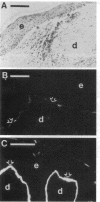Abstract
Epidermolysis bullosa (EB) in a group of genodermatoses characterized by the fragility of skin. Previous studies on the dystrophic (scarring) forms of EB have suggested abnormalities in anchoring fibrils, morphologically recognizable attachment structures that provide stability to the association of the cutaneous basement membrane to the underlying dermis. Since type VII collagen is the major component of the anchoring fibrils, we examined the genetic linkage of dominant dystrophic EB (EBDD) and the type VII collagen gene (COL7A1) locus, which we have recently mapped to chromosome 3p, in three large kindreds with abnormal anchoring fibrils. Strong genetic linkage of EBDD and COL7A1 loci was demonstrated with the maximum logarithm of odds (LOD) score of 8.77 at theta = 0. This linkage was further confirmed with two additional markers in this region of the short arm of chromosome 3, and these analyses allowed further refinement of the map locus of COL7A1. Since there were no recombinants between the COL7A1 and EBDD loci, our findings suggest that type VII collagen is the candidate gene that may harbor the mutations responsible for the EB phenotype in these three families.
Full text
PDF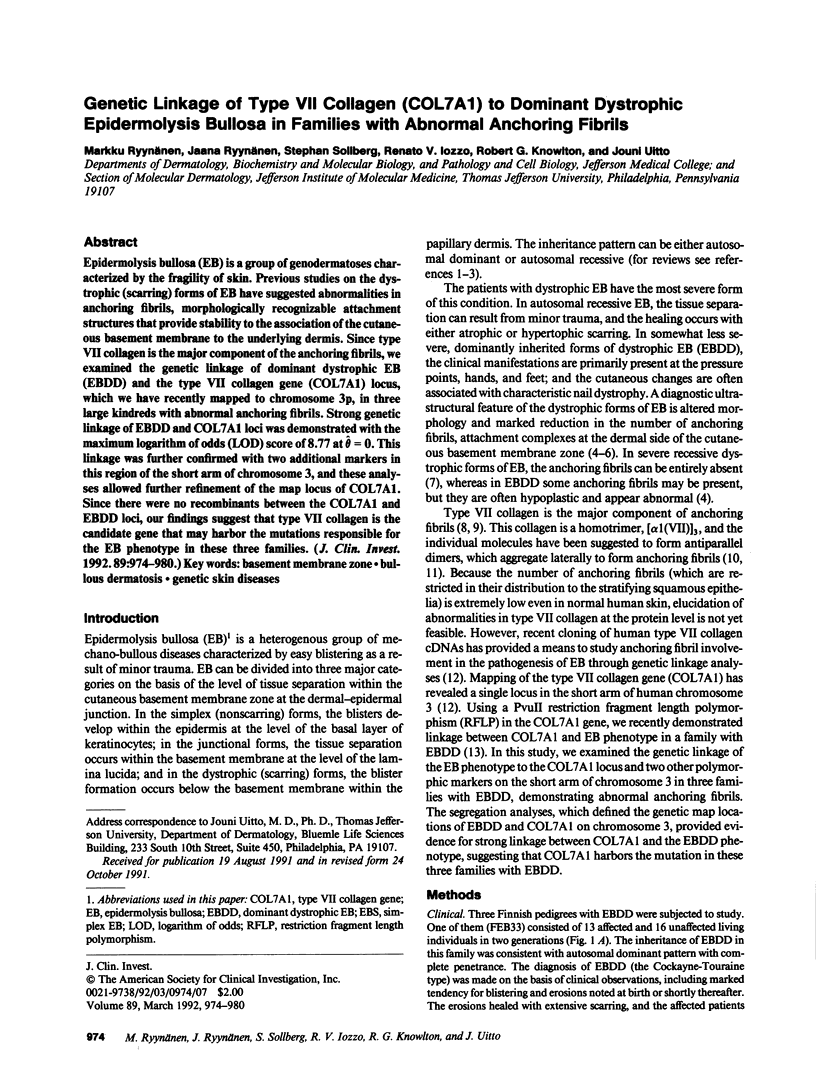
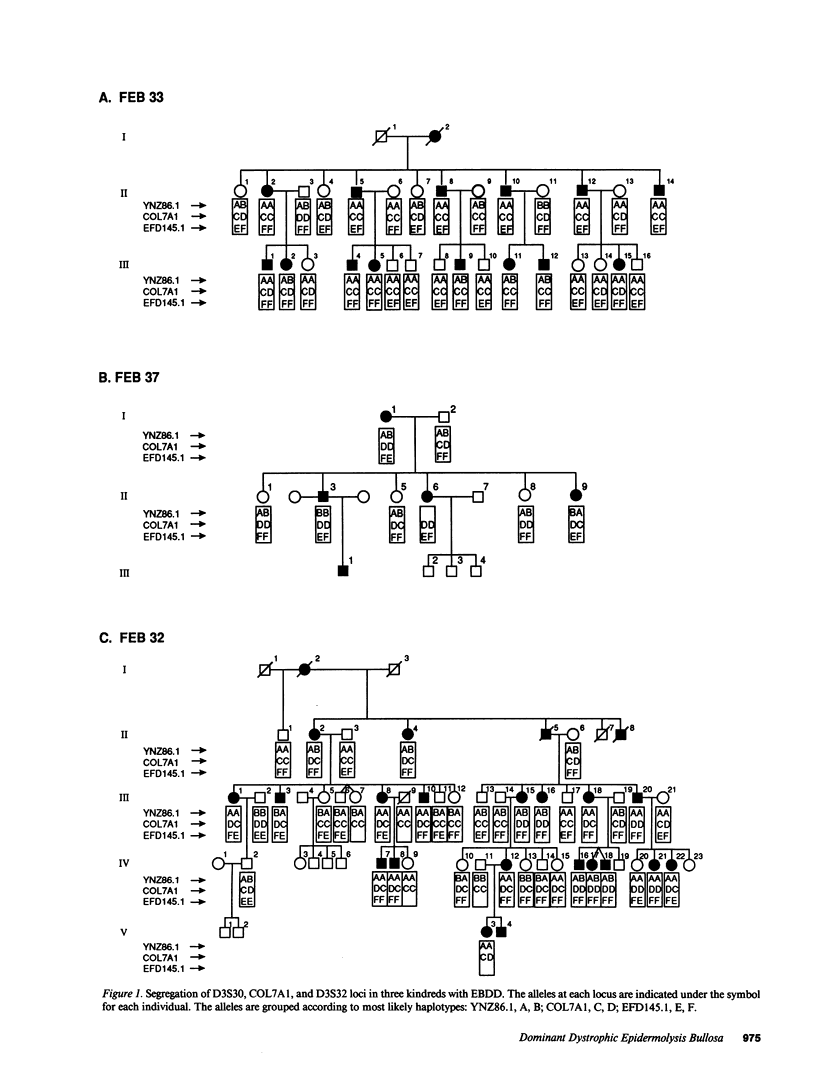
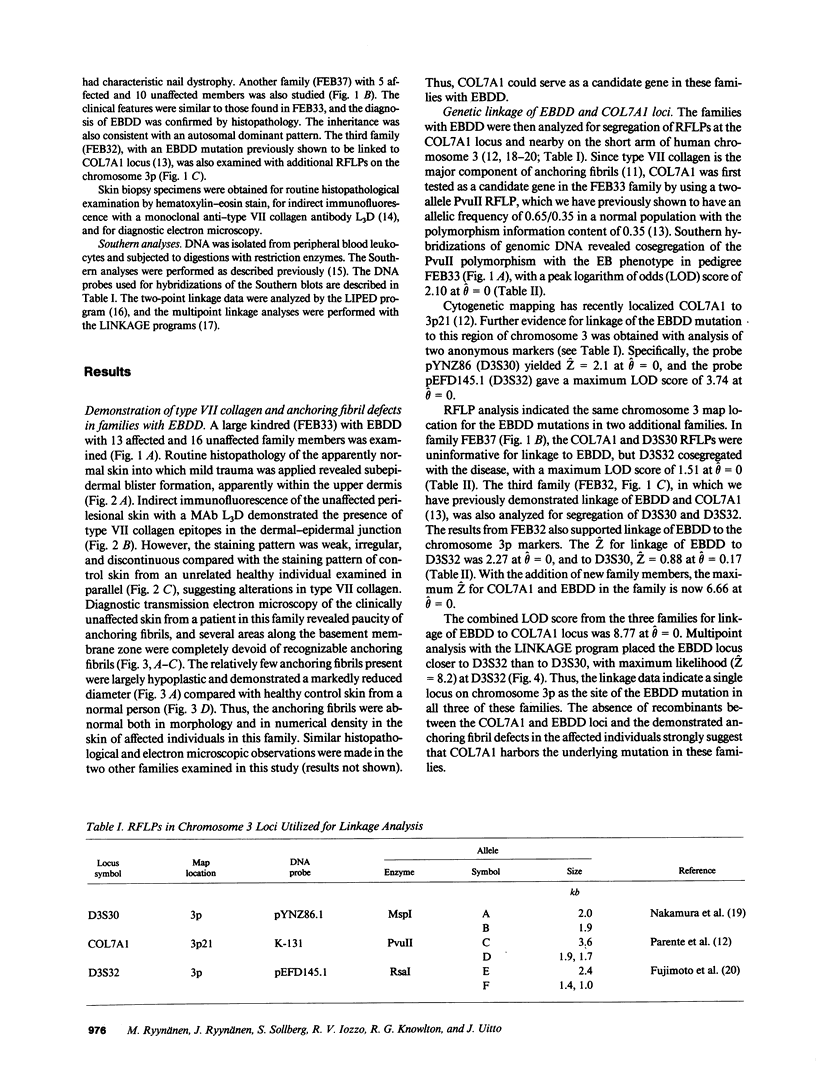
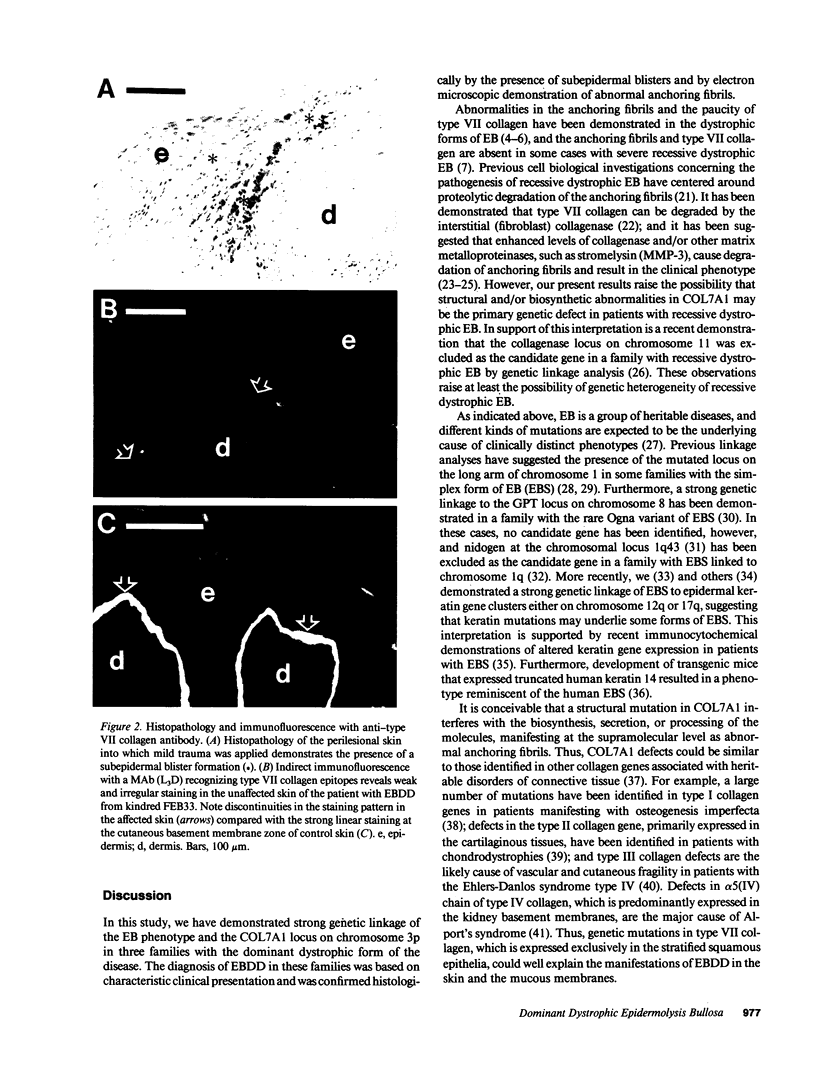
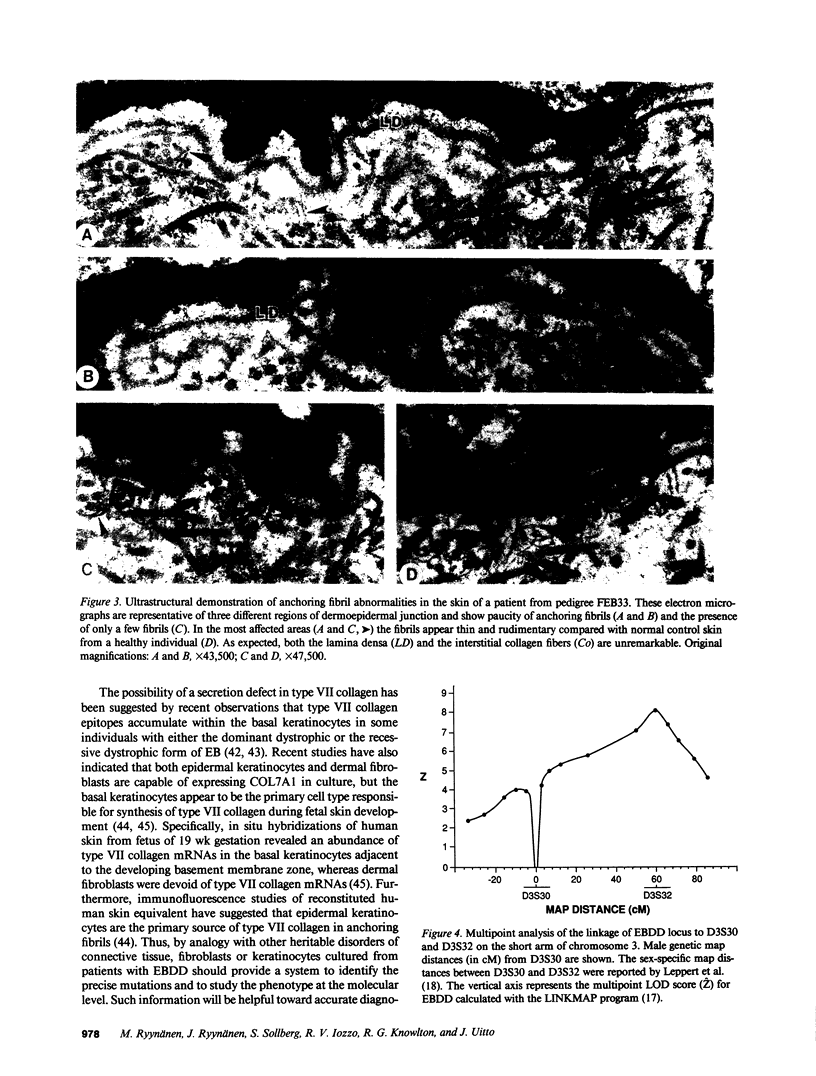
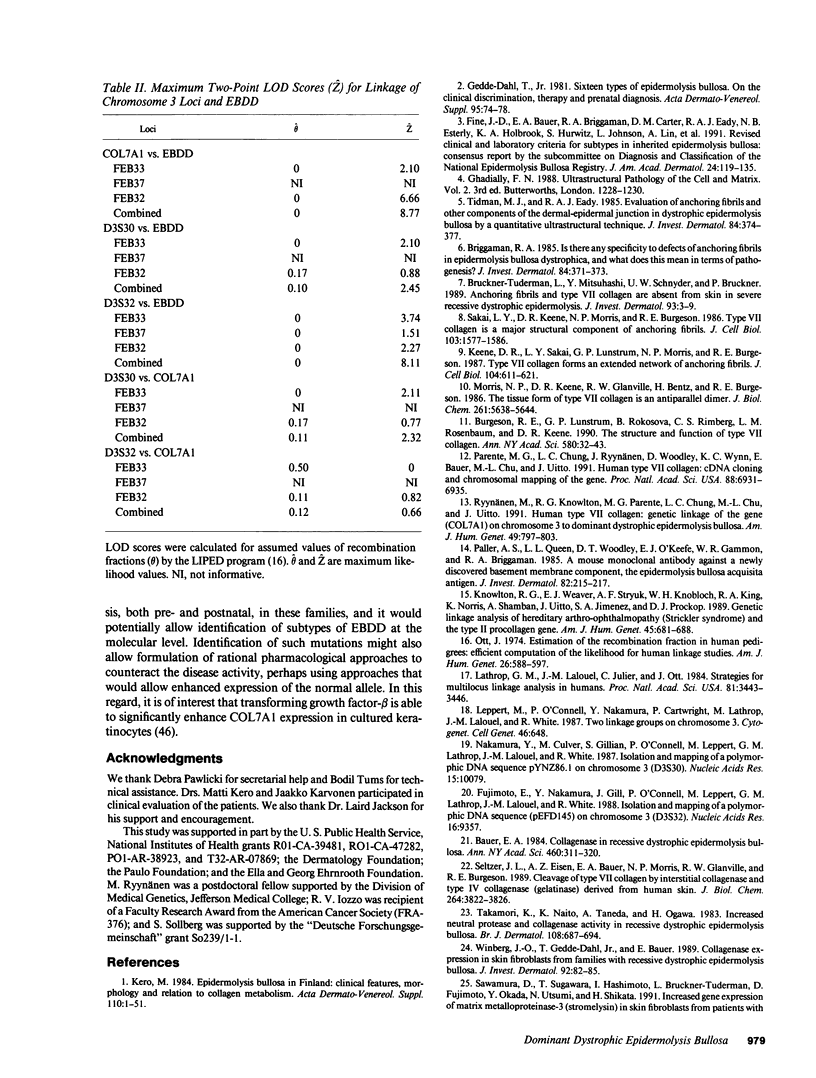
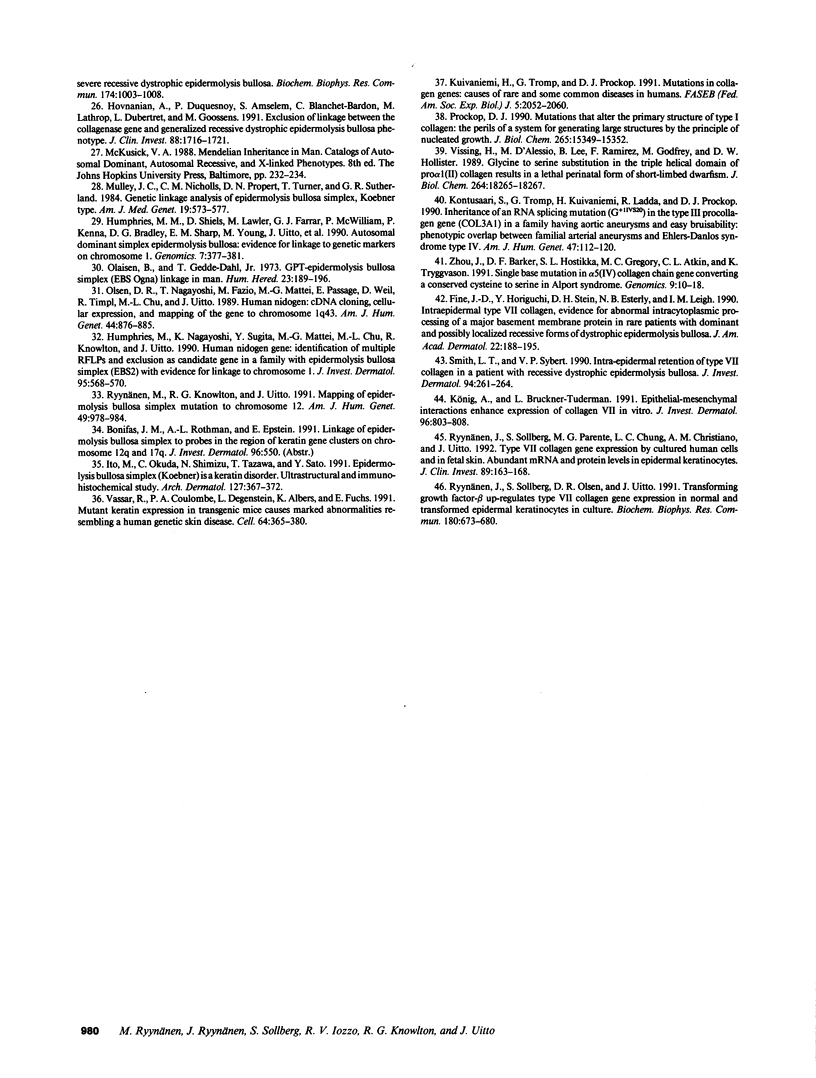
Images in this article
Selected References
These references are in PubMed. This may not be the complete list of references from this article.
- Bauer E. A. Collagenase in recessive dystrophic epidermolysis bullosa. Ann N Y Acad Sci. 1985;460:311–320. doi: 10.1111/j.1749-6632.1985.tb51178.x. [DOI] [PubMed] [Google Scholar]
- Briggaman R. A. Is there any specificity to defects of anchoring fibrils in epidermolysis bullosa dystrophica, and what does this mean in terms of pathogenesis? J Invest Dermatol. 1985 May;84(5):371–373. doi: 10.1111/1523-1747.ep12265450. [DOI] [PubMed] [Google Scholar]
- Bruckner-Tuderman L., Mitsuhashi Y., Schnyder U. W., Bruckner P. Anchoring fibrils and type VII collagen are absent from skin in severe recessive dystrophic epidermolysis bullosa. J Invest Dermatol. 1989 Jul;93(1):3–9. doi: 10.1111/1523-1747.ep12277331. [DOI] [PubMed] [Google Scholar]
- Burgeson R. E., Lunstrum G. P., Rokosova B., Rimberg C. S., Rosenbaum L. M., Keene D. R. The structure and function of type VII collagen. Ann N Y Acad Sci. 1990;580:32–43. doi: 10.1111/j.1749-6632.1990.tb17915.x. [DOI] [PubMed] [Google Scholar]
- Fine J. D., Bauer E. A., Briggaman R. A., Carter D. M., Eady R. A., Esterly N. B., Holbrook K. A., Hurwitz S., Johnson L., Lin A. Revised clinical and laboratory criteria for subtypes of inherited epidermolysis bullosa. A consensus report by the Subcommittee on Diagnosis and Classification of the National Epidermolysis Bullosa Registry. J Am Acad Dermatol. 1991 Jan;24(1):119–135. doi: 10.1016/0190-9622(91)70021-s. [DOI] [PubMed] [Google Scholar]
- Fine J. D., Horiguchi Y., Stein D. H., Esterly N. B., Leigh I. M. Intraepidermal type VII collagen. Evidence for abnormal intracytoplasmic processing of a major basement membrane protein in rare patients with dominant and possibly localized recessive forms of dystrophic epidermolysis bullosa. J Am Acad Dermatol. 1990 Feb;22(2 Pt 1):188–195. [PubMed] [Google Scholar]
- Fujimoto E., Nakamura Y., Gill J., O'Connell P., Leppert M., Lathrop G. M., Lalouel J. M., White R. Isolation and mapping of a polymorphic DNA sequence (pEFD145) on chromosome 3 [D3S32]. Nucleic Acids Res. 1988 Oct 11;16(19):9357–9357. doi: 10.1093/nar/16.19.9357. [DOI] [PMC free article] [PubMed] [Google Scholar]
- Gedde-Dahl T., Jr Sixteen types of epidermolysis bullosa. On the clinical discrimination, therapy and prenatal diagnosis. Acta Derm Venereol Suppl (Stockh) 1981;95:74–87. [PubMed] [Google Scholar]
- Hovnanian A., Duquesnoy P., Amselem S., Blanchet-Bardon C., Lathrop M., Dubertret L., Goossens M. Exclusion of linkage between the collagenase gene and generalized recessive dystrophic epidermolysis bullosa phenotype. J Clin Invest. 1991 Nov;88(5):1716–1721. doi: 10.1172/JCI115489. [DOI] [PMC free article] [PubMed] [Google Scholar]
- Humphries M. M., Sheils D., Lawler M., Farrar G. J., McWilliam P., Kenna P., Bradley D. G., Sharp E. M., Gaffney E. F., Young M. Epidermolysis bullosa: evidence for linkage to genetic markers on chromosome 1 in a family with the autosomal dominant simplex form. Genomics. 1990 Jul;7(3):377–381. doi: 10.1016/0888-7543(90)90171-p. [DOI] [PubMed] [Google Scholar]
- Humphries M., Nagayoshi T., Sheils D., Humphries P., Uitto J. Human nidogen gene: identification of multiple RFLP and exclusion as candidate gene in a family with epidermolysis bullosa (EBS2) with evidence for linkage to chromosome 1. J Invest Dermatol. 1990 Nov;95(5):568–570. doi: 10.1111/1523-1747.ep12505546. [DOI] [PubMed] [Google Scholar]
- Ito M., Okuda C., Shimizu N., Tazawa T., Sato Y. Epidermolysis bullosa simplex (Koebner) is a keratin disorder. Ultrastructural and immunohistochemical study. Arch Dermatol. 1991 Mar;127(3):367–372. [PubMed] [Google Scholar]
- Keene D. R., Sakai L. Y., Lunstrum G. P., Morris N. P., Burgeson R. E. Type VII collagen forms an extended network of anchoring fibrils. J Cell Biol. 1987 Mar;104(3):611–621. doi: 10.1083/jcb.104.3.611. [DOI] [PMC free article] [PubMed] [Google Scholar]
- Kero M. Epidermolysis bullosa in Finland. Clinical features, morphology and relation to collagen metabolism. Acta Derm Venereol Suppl (Stockh) 1984;110:1–51. [PubMed] [Google Scholar]
- Knowlton R. G., Weaver E. J., Struyk A. F., Knobloch W. H., King R. A., Norris K., Shamban A., Uitto J., Jimenez S. A., Prockop D. J. Genetic linkage analysis of hereditary arthro-ophthalmopathy (Stickler syndrome) and the type II procollagen gene. Am J Hum Genet. 1989 Nov;45(5):681–688. [PMC free article] [PubMed] [Google Scholar]
- Kontusaari S., Tromp G., Kuivaniemi H., Ladda R. L., Prockop D. J. Inheritance of an RNA splicing mutation (G+ 1 IVS20) in the type III procollagen gene (COL3A1) in a family having aortic aneurysms and easy bruisability: phenotypic overlap between familial arterial aneurysms and Ehlers-Danlos syndrome type IV. Am J Hum Genet. 1990 Jul;47(1):112–120. [PMC free article] [PubMed] [Google Scholar]
- Kuivaniemi H., Tromp G., Prockop D. J. Mutations in collagen genes: causes of rare and some common diseases in humans. FASEB J. 1991 Apr;5(7):2052–2060. doi: 10.1096/fasebj.5.7.2010058. [DOI] [PubMed] [Google Scholar]
- König A., Bruckner-Tuderman L. Epithelial-mesenchymal interactions enhance expression of collagen VII in vitro. J Invest Dermatol. 1991 Jun;96(6):803–808. doi: 10.1111/1523-1747.ep12474424. [DOI] [PubMed] [Google Scholar]
- Lathrop G. M., Lalouel J. M., Julier C., Ott J. Strategies for multilocus linkage analysis in humans. Proc Natl Acad Sci U S A. 1984 Jun;81(11):3443–3446. doi: 10.1073/pnas.81.11.3443. [DOI] [PMC free article] [PubMed] [Google Scholar]
- Morris N. P., Keene D. R., Glanville R. W., Bentz H., Burgeson R. E. The tissue form of type VII collagen is an antiparallel dimer. J Biol Chem. 1986 Apr 25;261(12):5638–5644. [PubMed] [Google Scholar]
- Mulley J. C., Nicholls C. M., Propert D. N., Turner T., Sutherland G. R. Genetic linkage analysis of epidermolysis bullosa simplex, Köbner type. Am J Med Genet. 1984 Nov;19(3):573–577. doi: 10.1002/ajmg.1320190320. [DOI] [PubMed] [Google Scholar]
- Nakamura Y., Culver M., Gillilan S., O'Connell P., Leppert M., Lathrop G. M., Lalouel J. M., White R. Isolation and mapping of a polymorphic DNA sequence pYNZ86.1 on chromosome 3 (D3S30). Nucleic Acids Res. 1987 Dec 10;15(23):10079–10079. doi: 10.1093/nar/15.23.10079. [DOI] [PMC free article] [PubMed] [Google Scholar]
- Olaisen B., Gedde-Dahl T., Jr GPT--epidermolysis bullosa simplex (EBS Ogna) linkage in man. Hum Hered. 1973;23(3):189–196. doi: 10.1159/000152573. [DOI] [PubMed] [Google Scholar]
- Olsen D. R., Nagayoshi T., Fazio M., Mattei M. G., Passage E., Weil D., Timpl R., Chu M. L., Uitto J. Human nidogen: cDNA cloning, cellular expression, and mapping of the gene to chromosome Iq43. Am J Hum Genet. 1989 Jun;44(6):876–885. [PMC free article] [PubMed] [Google Scholar]
- Ott J. Estimation of the recombination fraction in human pedigrees: efficient computation of the likelihood for human linkage studies. Am J Hum Genet. 1974 Sep;26(5):588–597. [PMC free article] [PubMed] [Google Scholar]
- Paller A. S., Queen L. L., Woodley D. T., Gammon W. R., O'Keefe E. J., Briggaman R. A. A mouse monoclonal antibody against a newly discovered basement membrane component, the epidermolysis bullosa acquisita antigen. J Invest Dermatol. 1985 Mar;84(3):215–217. doi: 10.1111/1523-1747.ep12265158. [DOI] [PubMed] [Google Scholar]
- Parente M. G., Chung L. C., Ryynänen J., Woodley D. T., Wynn K. C., Bauer E. A., Mattei M. G., Chu M. L., Uitto J. Human type VII collagen: cDNA cloning and chromosomal mapping of the gene. Proc Natl Acad Sci U S A. 1991 Aug 15;88(16):6931–6935. doi: 10.1073/pnas.88.16.6931. [DOI] [PMC free article] [PubMed] [Google Scholar]
- Prockop D. J. Mutations that alter the primary structure of type I collagen. The perils of a system for generating large structures by the principle of nucleated growth. J Biol Chem. 1990 Sep 15;265(26):15349–15352. [PubMed] [Google Scholar]
- Ryynänen J., Sollberg S., Olsen D. R., Uitto J. Transforming growth factor-beta up-regulates type VII collagen gene expression in normal and transformed epidermal keratinocytes in culture. Biochem Biophys Res Commun. 1991 Oct 31;180(2):673–680. doi: 10.1016/s0006-291x(05)81118-0. [DOI] [PubMed] [Google Scholar]
- Ryynänen J., Sollberg S., Parente M. G., Chung L. C., Christiano A. M., Uitto J. Type VII collagen gene expression by cultured human cells and in fetal skin. Abundant mRNA and protein levels in epidermal keratinocytes. J Clin Invest. 1992 Jan;89(1):163–168. doi: 10.1172/JCI115557. [DOI] [PMC free article] [PubMed] [Google Scholar]
- Ryynänen M., Knowlton R. G., Parente M. G., Chung L. C., Chu M. L., Uitto J. Human type VII collagen: genetic linkage of the gene (COL7A1) on chromosome 3 to dominant dystrophic epidermolysis bullosa. Am J Hum Genet. 1991 Oct;49(4):797–803. [PMC free article] [PubMed] [Google Scholar]
- Ryynänen M., Knowlton R. G., Uitto J. Mapping of epidermolysis bullosa simplex mutation to chromosome 12. Am J Hum Genet. 1991 Nov;49(5):978–984. [PMC free article] [PubMed] [Google Scholar]
- Sakai L. Y., Keene D. R., Morris N. P., Burgeson R. E. Type VII collagen is a major structural component of anchoring fibrils. J Cell Biol. 1986 Oct;103(4):1577–1586. doi: 10.1083/jcb.103.4.1577. [DOI] [PMC free article] [PubMed] [Google Scholar]
- Sawamura D., Sugawara T., Hashimoto I., Bruckner-Tuderman L., Fujimoto D., Okada Y., Utsumi N., Shikata H. Increased gene expression of matrix metalloproteinase-3 (stromelysin) in skin fibroblasts from patients with severe recessive dystrophic epidermolysis bullosa. Biochem Biophys Res Commun. 1991 Jan 31;174(2):1003–1008. doi: 10.1016/0006-291x(91)91518-h. [DOI] [PubMed] [Google Scholar]
- Seltzer J. L., Eisen A. Z., Bauer E. A., Morris N. P., Glanville R. W., Burgeson R. E. Cleavage of type VII collagen by interstitial collagenase and type IV collagenase (gelatinase) derived from human skin. J Biol Chem. 1989 Mar 5;264(7):3822–3826. [PubMed] [Google Scholar]
- Smith L. T., Sybert V. P. Intra-epidermal retention of type VII collagen in a patient with recessive dystrophic epidermolysis bullosa. J Invest Dermatol. 1990 Feb;94(2):261–264. doi: 10.1111/1523-1747.ep12874614. [DOI] [PubMed] [Google Scholar]
- Takamori K., Naito K., Taneda A., Ogawa H. Increased neutral protease and collagenase activity in recessive dystrophic epidermolysis bullosa. Br J Dermatol. 1983 Jun;108(6):687–694. doi: 10.1111/j.1365-2133.1983.tb01081.x. [DOI] [PubMed] [Google Scholar]
- Tidman M. J., Eady R. A. Evaluation of anchoring fibrils and other components of the dermal-epidermal junction in dystrophic epidermolysis bullosa by a quantitative ultrastructural technique. J Invest Dermatol. 1985 May;84(5):374–377. doi: 10.1111/1523-1747.ep12265460. [DOI] [PubMed] [Google Scholar]
- Vassar R., Coulombe P. A., Degenstein L., Albers K., Fuchs E. Mutant keratin expression in transgenic mice causes marked abnormalities resembling a human genetic skin disease. Cell. 1991 Jan 25;64(2):365–380. doi: 10.1016/0092-8674(91)90645-f. [DOI] [PubMed] [Google Scholar]
- Vissing H., D'Alessio M., Lee B., Ramirez F., Godfrey M., Hollister D. W. Glycine to serine substitution in the triple helical domain of pro-alpha 1 (II) collagen results in a lethal perinatal form of short-limbed dwarfism. J Biol Chem. 1989 Nov 5;264(31):18265–18267. [PubMed] [Google Scholar]
- Winberg J. O., Gedde-Dahl T., Jr, Bauer E. A. Collagenase expression in skin fibroblasts from families with recessive dystrophic epidermolysis bullosa. J Invest Dermatol. 1989 Jan;92(1):82–85. doi: 10.1111/1523-1747.ep13071274. [DOI] [PubMed] [Google Scholar]
- Zhou J., Barker D. F., Hostikka S. L., Gregory M. C., Atkin C. L., Tryggvason K. Single base mutation in alpha 5(IV) collagen chain gene converting a conserved cysteine to serine in Alport syndrome. Genomics. 1991 Jan;9(1):10–18. doi: 10.1016/0888-7543(91)90215-z. [DOI] [PubMed] [Google Scholar]



